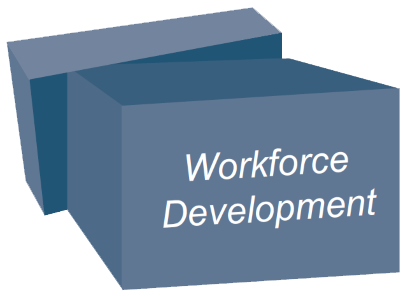This Program In a Box shows ways that State Energy Offices can leverage federal funding to prepare their workforce for careers in growing energy sectors. Training the next generation of the energy workforce is critical to meeting state goals, and to help ensure economic competitiveness. State Energy Offices and their public-and private-sector partners can better achieve clean energy, economic development, and climate goals by enhancing the quality of – and access to – trainings and apprenticeships.
Benefits for States that Implement a Workforce Development Program
- A well-trained energy workforce supports the success of businesses and employees, promotes growth and competitiveness into a state’s energy industry, and can thereby increase state and local tax revenue and economic bases.
- Targeted workforce investments in specific clean energy sectors can create significant growth and competitive advantage in newer industries (for example: offshore wind).
- Workforce programs can help small businesses gain access to a trained labor pool, while attracting workers to on-the-job training.
- Investments by state agencies (often partnering with a state’s Department of Labor) help to ensure quick access to a large, skilled workforce for energy infrastructure investments.
- When designed with equity and inclusion principles at their center, workforce development programs can support economic mobility and opportunity for those who have been historically underrepresented in the energy workforce or marginalized by polluting industries.
How Communities Benefit from Workforce Development Investments
- Local businesses and organizations can grow and succeed by gaining access to a qualified and trained workforce.
- Funding provides workers with trainings and apprenticeships that increase their value in the job market, leading to higher wages, standards of living, and professional satisfaction.
- Workforce training enables the advancement of workers throughout an organization, which spurs hiring of additional entry-level workers.
- Well-designed workforce development programs often partner with NGOs and academic institutions that can continue investments if federal funds are no longer available.
- These benefits accrue and multiply over time, creating positive ripple effects within local communities.
Examples Used to Develop This Program In a Box
Thank you to Maryland and New York energy professionals who generously shared their knowledge and experiences for this Workforce Development Program In a Box.
See the Maryland program .
See the New York State program .
Staff at the Maryland Energy Administration (MEA) provided information on their Offshore Wind Workforce Training Program.
The Maryland Offshore Wind Workforce Training Program, established in 2018, provides existing training centers and higher educational institutions with resources to expand their curriculum and training offerings. It was created to prepare the state’s workforce for careers in the nascent and growing offshore wind industry. Maryland set a goal to develop two gigawatts of offshore wind generation. The program specifically provides funding to supplement and boost the expansion of existing entities, enabling training centers to make capital improvements to prepare entry-level workers for careers focused on wind energy.
Staff at the New York State Energy and Research Development Authority (NYSERDA) provided information on their On-The-Job Training (OTJ) for Energy Efficiency and Clean Technology Program.
The On-The-Job Training for Energy Efficiency and Clean Technology Program was established to provide energy efficiency and clean energy businesses with access to a sufficient supply of workers who could be trained on the job, with reduced financial risk to the employer. The Program Opportunity Notice (PON) 3982 offers $15 million through December 31, 2024. The OTJ program works with businesses by subsidizing new-hire wages. The New York Department of Labor (DOL) assists with the development of training plans for employees hired by businesses utilizing the OTJ program, in addition to connecting businesses with prospective workers.
Maryland’s and New York’s workforce development programs represent initiatives to boost worker training. Both states offer more for energy workforce development than the examples described here. This Program In a Box deals specifically with State Energy Office supported workforce development programs, but doesn’t address other ways states can support workforce development and job quality (by requiring training, local hiring, or recruitment of women and minorities in state-funded projects).

